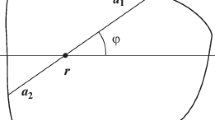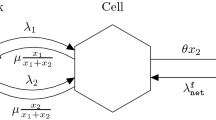Abstract
Radio communication offers the great advantage of mobility for users. At least two important systems exploit this feature: packet radio networks and personal communication systems. Since their radio links are subject to rapid changes in quality, the ability to adapt to these changes has much to offer in improving throughput, delay, and robustness characteristics. This paper addresses three areas. First, it presents the design fundamentals of an adaptive link-gain control algorithm for a multiple access radio channel. Second, it develops a probabilistic model for a related family of algorithms, which includes models for the effects of code-division multiple access interference. Third, it uses two sample algorithms to explore the transient behaviour of the system. The two algorithms are chosen to compare the relative merits of designs that emphasize adapting to channel noise versus adapting to multiple access interference. Transient analysis is sparse in the literature and is an important contribution of this paper.
Similar content being viewed by others
References
Proposed wideband spread spectrum standard, Draft Revision X1. Technical Report, TIA TR45 Committee (1992).
A. Bigloo, T. Gulliver, Q. Wang and V. Bhargava, A robust rate-adaptive hybrid ARQ scheme for frequency-hopped spread-spectrum multiple-access communication systems, IEEE J. Selec. Areas Commun. 12 (1994) 917–924.
A.B. Carleial and M.E. Hellman, Bistable behavior of ALOHA-type systems, IEEE Trans. Commun. COM-23(4) (1975).
J. Escobar, Radio-parameter selection algorithm for receiverdirected packet-radio networks (SRNTN-73), BBN, Technical Report 7172, Cambridge, MA (1989).
E. Geraniotis and J. Wu, The probability of multiple correct packet receptions in direct-sequence spread-spectrum networks, IEEE J. Select. Areas Commun. 12 (1994) 871–884.
J. Escobar, G. Lauer and M. Steenstrup, Performance analysis of rate-based congestion control algorithm for receiver-directed packet-radio networks,IEEE MILCOM 90 (1990) 27.4.1–27.4.7.
J. Storey and F. Tobagi, Throughput performance of an unslotted direct-sequence SSMA packet radio network, IEEE Trans. Commun. COM-37(8) (1989).
J. Zavgren and G. Lauer, The performance improvement from receiver-directed packet transmission in spread-spectrum packet-radio networks,Proc. 1988 Tactical Communications Conf., 1988, pp. 65–72.
J. Hastad, T. Leighton and B. Rogoff, Analysis of backoff protocols for multiple access channels,ACM Proc. 19th Annual Symp. on Theory of Computing, 1987.
J.M. Wozencraft and I.M. Jacobs,Principles of Communication Engineering (Wiley, 1965).
J. Jubin and J. Tornow, The DARPA packet radio network protocols,Proc. IEEE: Special Issue on Packet Radio Networks, 75(1) (1987).
G. Lauer, Survivable packet radio network protocols,NATO, Shape Technical Center Conf. III(1) (1989) R.1–R.15.
R.A. Howard,Dynamic Probabilistic Systems, Vol.II: Semi-Markov and Decision Processes (Wiley).
E.G. Tiedemann, A.B. Salmasi and A.B. Gilhousen, The design and development of a code division multiple access (CDMA) system for celullar and personal radio communications,IEEE Int. Symp. on Personal, Indoor and Mobile Radio Communications, London, 1991.
W. Fifer and F. Bruno, The low-cost packet radio, Proc. IEEE 75(1) (1987).
Y.C. Jenq, Optimal retransmission control of slotted ALOHA systems, IEEE Trans. Commun. COM-29(6) (1985).
J. Zavgren, The moment-of-silence channel-access algorithm,Proc. IEEE MILCOM 89, 2 (1989) 20.3.1–20.3.7.
Author information
Authors and Affiliations
Rights and permissions
About this article
Cite this article
Escobar, J. Run-away dynamics of CDMA channels in an adaptive packet radio network. Wireless Netw 1, 37–46 (1995). https://doi.org/10.1007/BF01196257
Received:
Issue Date:
DOI: https://doi.org/10.1007/BF01196257




